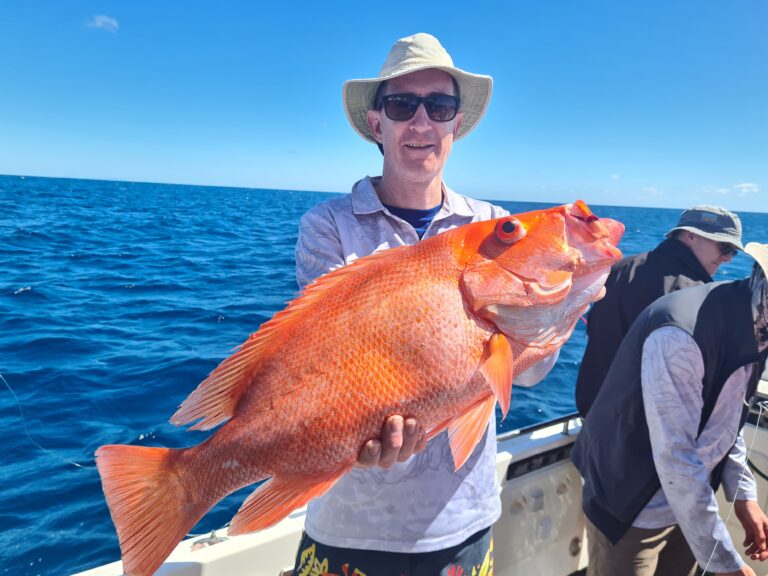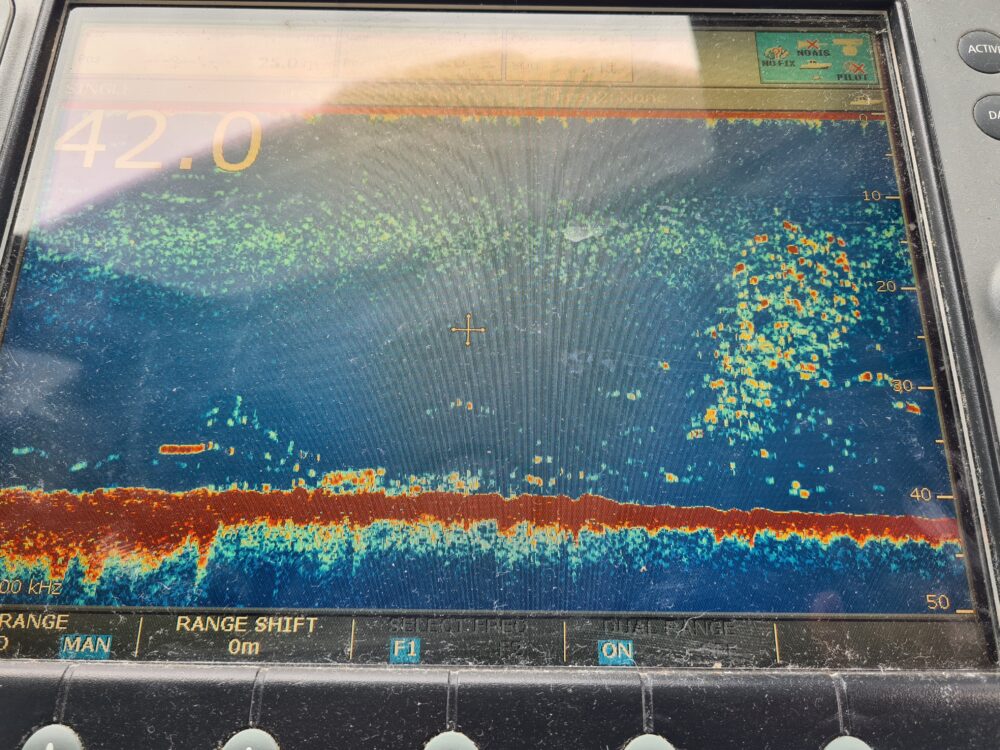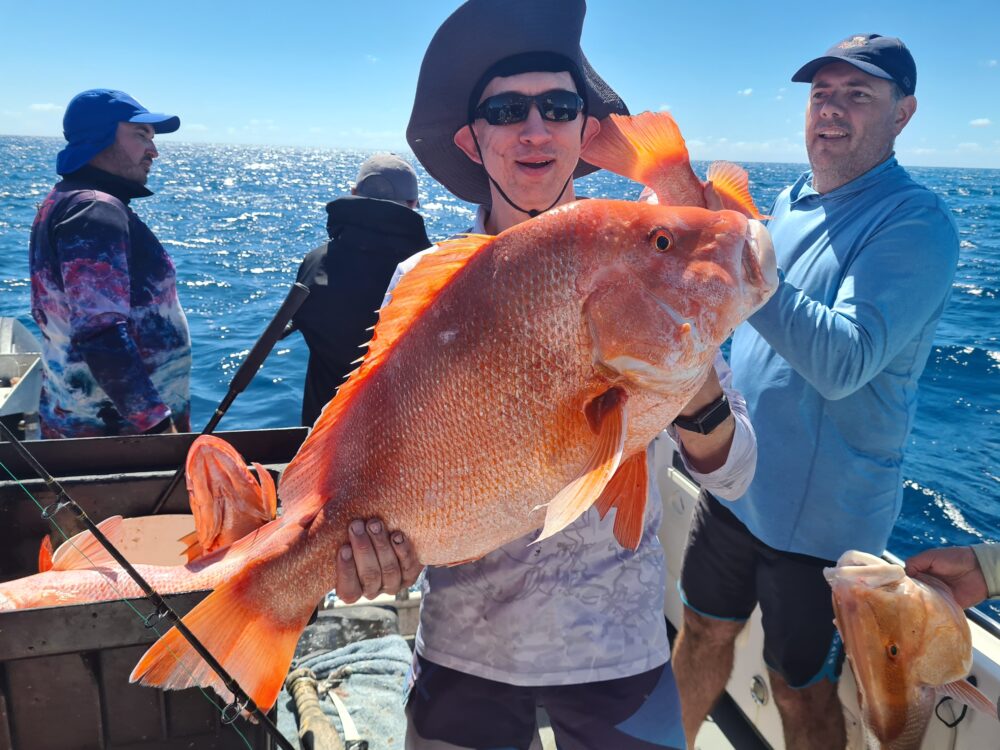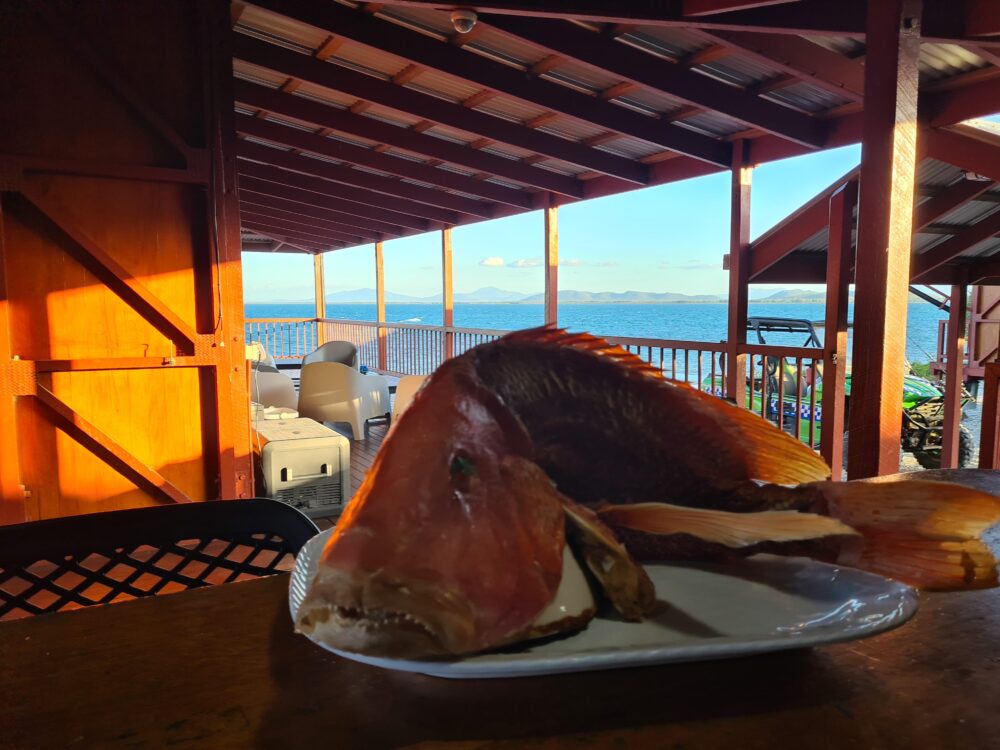When Less is Best – By Adam Finlay
After returning from a week-long trip at the Lodge I’ve pondered at the thought of what I would write for the next article. After looking back over the previous week and what we faced both weather and fishing wise, I thought it was a great opportunity to let some readers in on our thought processes when not only targeting certain species but also targeting new grounds from a Charter Guide’s perspective.
We run 4-8 day trips fairly regularly out of Camp Island Lodge which is a short run north of Bowen, or for us, more of a 5 hour steam down from Townsville.
This week started off like any other with the run down in the 37 footer. Clients normally settle in for a relax on day one and usually have an arvo cruise to try and knock a Spanish or 2 on the head for the Chef. Then day 2 is a full on reef trip and so on.
This week was looking like a very tough week weather wise with 20 knots being the best days and would only allow us a max of two possible days to get out to the reef if that.
With the weather being like this, it meant we would be in desperate need for reef shelter once out there as the swell was not to anyone’s liking. Wind direction meant that we only really had one option and that was to hide and play in behind the largest reef.
This direction also created another dilemma in regards to any known marks or fish areas from previous trips. The area we fished was baron on my sounder (marks wise) and over the years all I had ever did was a single mackerel troll, which never produced.
On charter we get thrown curve balls from time to time and this definitely was one of them.
Utilising all you have in regards to technology is the starting point to finding new grounds.
Contours and map overlays can be a very useful tool when first looking at new areas. These will give you the knowledge first up on a few key factors which will help train you in what you should be looking for within your preferred area.
Isolated shoals and steep contour ridges around reefs will give that option of aggressive shoal and coral country which can hold great numbers of both reefies as well as reds and undesirables like the trevally species, Chinaman and small mouth nannies.
These areas are pretty easy to find and included in this article is a not so great sounder picture of what can be seen. Bottom fish such as reds, nannygai, Chinaman, trout, cod etc can be seen on the rubble. While the pressure point areas will see pelagics foraging bait up through the water column.
My issue with finding and fishing these areas is that they are pretty easy to find and therefore means they will get fished a lot by other vessels. This was noted on our first bottom drop of the day. Landing around 25 Chinaman fish with at least a dozen over the metre mark, 2 triggerfish and 3 coral trout.
Over the years, when fishing known spots, it is easy to see how much boat action has been on an area due to good numbers of Chinaman and triggerfish and less of the more desired reds species.
This is due to the unbalanced amount of released species. An area can’t sustain the removal of a high percentage of desirable species like red emps and large mouth nannygai and then releasing aggressive species such as Chinaman and triggerfish. It doesn’t take long to ruin these areas and have them overrun by such species and this was easily seen on this patch.
In time I feel that this definitely needs to be looked at by Queensland Fisheries and eventually lifting the ban on Chinaman from the protected species list and having them on a separate category where they can at least be used for bait and removed from areas of high concentration which will allow the growth of other key species in numbers to flourish. But this is only my take and opinion.
Moving on from that spot I repeated my process to find another patch around 500m away and to my annoyance we were left with the same results. Bulk undesirables. This is where you sometimes need to think outside the box and look for smaller grounds that aren’t seen on any gps. These are just random patches that can only be found with time on water and days such as these allow for this.
I’m sure everyone has heard the ‘Less is Best’ theory. Well there is a number of reasons and meanings for this but here are a few.
First, the meaning of the ‘Less is Best’ is that smaller isolated grounds tend to hold the greater quality of reds in the area.
Sometimes these small lumps, hard shoals and high grit areas are home to more Crustaceans and Cephalopods than high fish congregation areas. This means quality sized fish usually hold on these grounds.
You then have the benefits that when you find these isolated hard bottom areas that you may be the first to fish it. Virgin ground is what every angler dreams of but most will never find it. Even when they think they have, it has most likely been fished, just not overfished.
The best example of the ‘Less is Best’ meaning refers to what you are seeing on the sounder on these spots.
Areas with less than a metre show on the bottom are normally passed over and not fished by most anglers who are on the search for the Christmas Tree style sounder shots.
Yet if you imagine 20 reds sitting hard on the shoal or firm bottom then this would logically not show up as much on the sounder. Most of the time reds can be misinterpreted for rubble or weed and even with a quality bottom lock or zoom function most anglers aren’t aware of what is actually beneath them if the fish aren’t active.
For us, we run a very narrow beam transducer which helps pinpoint the fish congregations which then worked in with the gps will isolate exact positions of fish to then aid and allow our anchoring process to be spot on. A lot of fisherman will use 2 styles of transducer and chop and change between the narrow when pinpointing or wide spread beam when searching for new ground. For us we just run the narrow and it serves well.
Back to the fishing, and after the Chinaman spots I decided I needed to find some better quality and isolated fish as we only had a few coral trout in the esky for Richard our chef.
So the best and easiest way to find such areas is to flick a few troll rods out the back. This time of year is great for finding new ground due to the high pelagic presence as there are some quality fish to be landed while looking over new ground. Two birds with one stone as they say.
These areas do take time to find and you may stumble across them in 10 minutes or it could take 10 hours. Also not to put a dampener on it, not every hard bottom patch is a gold mine and it can eat into your time. But when you do find them then they are worth it.
The key to looking for these patches is to zig zag in and out of the reef edge. I generally look from the flat bottomed deep areas down to 60m of depth and up to 25m or so. What this does is also allow you to find good trout and mixed reef species spots as well as when dropping off the reef edges onto the paddock flats you will find isolated patches. Anywhere up to 500m off the reef then back again and grid your search patterns and keep them on your gps saved as an alternate track colour. This means even if you have 20 mins on a day you can continue your search and not be accidentally looking over the same ground in the past.
After a good troll which landed a few different mackerel species for dinner we dropped anchor on the best patch I had found. Around 10 mins went by with just small pickers and no great fish being hooked. Being patient on these fish isn’t my greatest attribute as a guide as if we aren’t catching fish, I want to push on to areas that possibly will produce better. So I get itchy after 10 minutes or so and we tend to move around the 15 minute mark if nothing decent has been landed.
Luckily the first red Emperor was hooked. Then followed by the second, then a mid- sized largemouth and then every rod was hooked up every drop until we took time out for some pictures. End tally was about 25 reds off the one small patch.
As always, we put a stop to the numbers over the side as we want to be able to utilise such spots into the future. Normally 20 reds is our cut-off per spot (mixture of emps and largies). So, while all the fish were not processed we took some happy snaps and then spiked, bled and placed them on ice.
Spots such as these show just what can be done by wanting, or should I say needing to find ground. Especially this reef which has a high amount of recreational traffic. So it was great to still be able to find areas.
Also a quick tip for anyone starting out on both finding mixed reef species as well as reds is that the South-Western corner of every reef system we fish has a good number of areas.
This has to do with our tidal current direction around our coastline and reefs, especially around the Townsville region. The South-Western corner of our reefs will always have the most constant flow of tidal current which then creates the lift of micro organisms into the water column which then sources food for bait species and the aggregation of fish follow.










